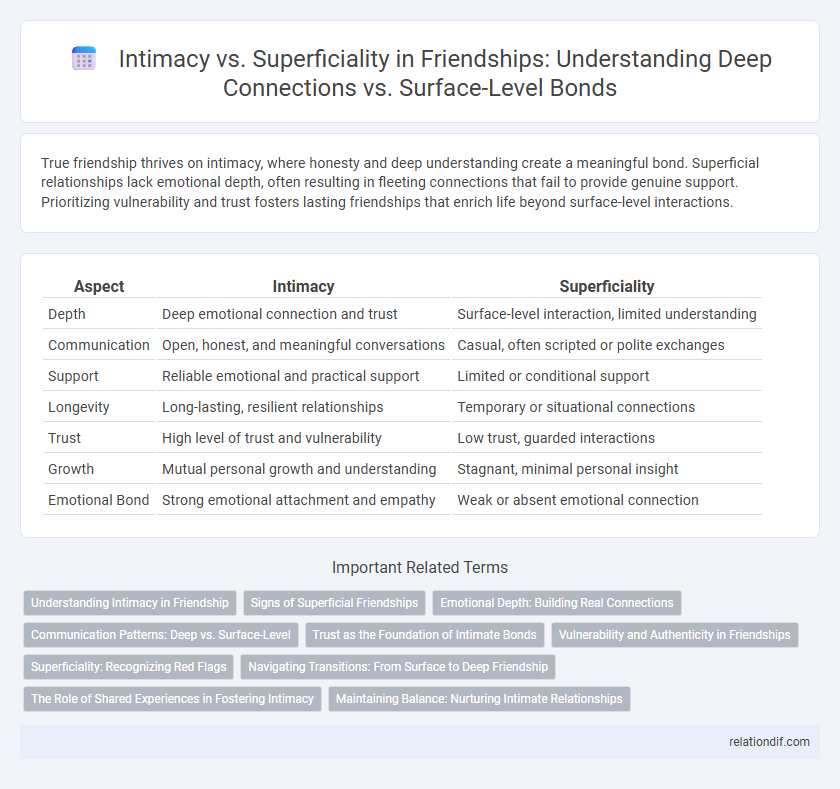True friendship thrives on intimacy, where honesty and deep understanding create a meaningful bond. Superficial relationships lack emotional depth, often resulting in fleeting connections that fail to provide genuine support. Prioritizing vulnerability and trust fosters lasting friendships that enrich life beyond surface-level interactions.
Table of Comparison
| Aspect | Intimacy | Superficiality |
|---|---|---|
| Depth | Deep emotional connection and trust | Surface-level interaction, limited understanding |
| Communication | Open, honest, and meaningful conversations | Casual, often scripted or polite exchanges |
| Support | Reliable emotional and practical support | Limited or conditional support |
| Longevity | Long-lasting, resilient relationships | Temporary or situational connections |
| Trust | High level of trust and vulnerability | Low trust, guarded interactions |
| Growth | Mutual personal growth and understanding | Stagnant, minimal personal insight |
| Emotional Bond | Strong emotional attachment and empathy | Weak or absent emotional connection |
Understanding Intimacy in Friendship
Understanding intimacy in friendship involves recognizing the depth of emotional connection and mutual trust that surpasses superficial interactions. True intimacy fosters open communication, vulnerability, and empathy, allowing friends to share core values and personal experiences. This depth strengthens bonds and creates a supportive, lasting relationship beyond casual acquaintanceship.
Signs of Superficial Friendships
Superficial friendships often lack genuine emotional connection, marked by conversations that revolve around trivial topics or social media interactions rather than personal experiences or feelings. These relationships tend to be inconsistent, with friends being available only during convenient moments or for mutual benefits rather than offering support during difficult times. Signs include minimal trust, avoidance of deep or vulnerable discussions, and a visible hesitation to invest time and effort into nurturing the bond.
Emotional Depth: Building Real Connections
Emotional depth is essential for building real connections in friendship, as it fosters trust, empathy, and mutual understanding. Genuine intimacy involves sharing vulnerabilities and authentic experiences, moving beyond superficial interactions. Such profound emotional bonds create lasting relationships that offer meaningful support and fulfillment.
Communication Patterns: Deep vs. Surface-Level
Effective friendship thrives on communication patterns that prioritize deep, meaningful conversations over surface-level exchanges, fostering emotional intimacy and trust. Sharing personal thoughts, feelings, and experiences cultivates a stronger bond compared to casual small talk focusing on external or trivial topics. Consistent openness and active listening enhance connection depth, distinguishing genuine friendships from superficial relationships.
Trust as the Foundation of Intimate Bonds
Trust serves as the cornerstone of intimate friendships, fostering emotional safety and open communication. Unlike superficial connections that rely on casual interactions, intimate bonds thrive on consistent honesty and vulnerability. This deep trust enables friends to support each other authentically and navigate challenges with confidence.
Vulnerability and Authenticity in Friendships
True friendship thrives on vulnerability, allowing individuals to share their deepest fears and aspirations without fear of judgment. Authentic connections surpass superficial interactions by fostering trust and emotional safety, which strengthen bonds over time. Embracing openness and honesty in friendships cultivates lasting intimacy that enriches personal growth and mutual understanding.
Superficiality: Recognizing Red Flags
Superficial friendships often display red flags such as inconsistent communication, lack of emotional support, and a focus on surface-level interactions rather than genuine connection. These relationships may involve frequent unmet promises, shallow conversations, and avoidance of vulnerability, signaling a lack of true intimacy. Recognizing these signs early helps individuals invest time in meaningful friendships that foster trust and mutual understanding.
Navigating Transitions: From Surface to Deep Friendship
Navigating transitions from superficial to deep friendship involves building trust through consistent sharing and active listening, allowing vulnerabilities to surface naturally. Emotional intimacy develops as friends move beyond small talk to engage in meaningful conversations, fostering mutual understanding and support. This gradual shift strengthens the bond, transforming casual acquaintances into lasting, authentic relationships.
The Role of Shared Experiences in Fostering Intimacy
Shared experiences create strong emotional bonds that transform casual acquaintances into deep friendships by fostering trust and mutual understanding. Engaging in meaningful activities together allows individuals to reveal personal values and vulnerabilities, enhancing intimacy. This contrasts with superficial interactions, which lack the depth needed to build lasting connections.
Maintaining Balance: Nurturing Intimate Relationships
Maintaining balance in friendships involves nurturing intimacy through open communication, trust-building, and shared experiences while avoiding superficial interactions that hinder genuine connection. Prioritizing emotional vulnerability and active listening fosters deeper bonds and mutual understanding. Consistent efforts to support one another reinforce intimacy, ensuring relationships thrive beyond surface-level engagement.
Intimacy vs Superficiality Infographic

 relationdif.com
relationdif.com